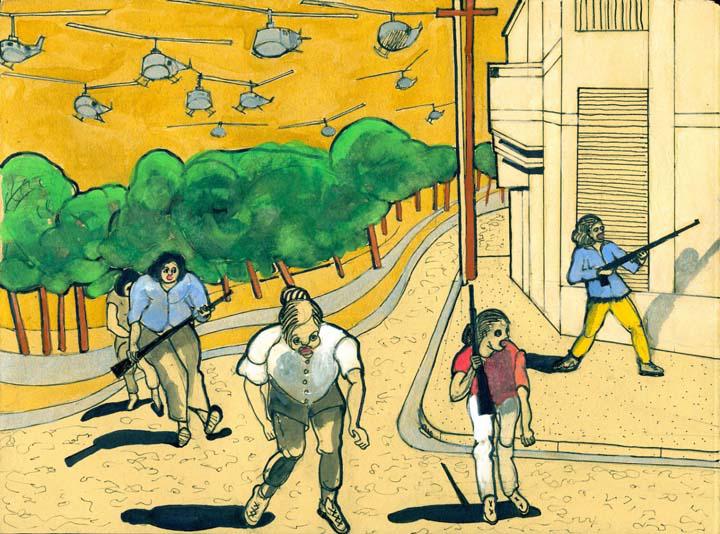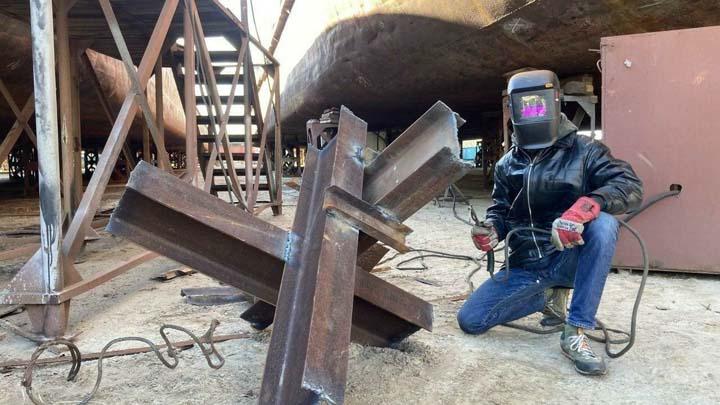The DART Board: 03.09.2022
This just in from ArtNet News: When the Ukrainian painter Volo Bevza left his apartment in Berlin to attend the opening of his solo exhibition in Kyiv last month, he never imagined that he would end up in the middle of a war zone, using his artistic skills not to create sculptures, but to construct anti-tank metal structures known as “hedgehogs.” Above: An artist called Alex welding a Czech hedgehog © Kosmos for The Observer/France 24

Once there, Bevza and the Pidust siblings began contributing to local territorial defense efforts…making metal structures known as “hedgehogs” [left] at a factory five minutes from the apartment where they were staying. (The spiky structures, which are made with metal beams and chains, are known as Czech hedgehogs because they were originally used at the Czech-German border during World War II.)
He and his companions are now contemplating their next move. Men ages 18 to 60 aren’t allowed to leave the country. As a Ukrainian citizen, this prohibition also applies to Bevza, who teaches at the Weissensee School of Art and Design in Berlin. He hopes that the school may help him obtain exit papers, “but the chances are slim,” he said. In the meantime, they’ve been heartened by the outpouring of support from their friends and networks in Europe. “The support has been unreal,” said Victoria Pidust, 29…About 20 of their friends are driving from Berlin to help the wounded as medical volunteers. Another Ukrainian friend is returning to his homeland from Los Angeles. Ukraine’s Interior Ministry said 80,000 Ukrainian citizens, almost all men, have returned from abroad since February 24 to help fight for their country.
From The Observers/France 24: [Another] artist called Bodia used to organise cultural events in a community centre in northern Kyiv. Now he works 12 hours a day making giant anti-tank barricades known as "hedgehogs" aimed at stopping tanks. It is yet another example of how Ukrainian civilians are supporting troops as they try to repel Russia’s advance.
“We work from 8am to 8pm, everyday, without breaks. Since the beginning of the war, we have made 150 anti-tank barricades. We have been working in a shipyard and a nearby boat factory has been providing us with lots of the material. We have also begun making bulletproof vests and we coordinate with NGOs around Europe for supplies and support.” —Bodia

In Memorium
Noni Olabisi, a visual artist whose provocative murals such as “To Protect and Serve,” with its powerful portrait of the Black Panthers, galvanized communities in South Los Angeles, has died. She was 67. Photo above: Patrick Downs / Los Angeles Times
In the mid-1990s, Olabisi’s most noted mural became a point of contention among power brokers and collective stakeholders in Los Angeles. “To Protect and Serve” [the motto of the LAPD] was one of the first murals to address the history of police brutality; it showed a bound and gagged Bobby Seale, co-founder of the Black Panther Party and a defendant in the 1969 Chicago Eight trial (later the Chicago Seven trial after Seale’s case was severed from that of the other defendants), under the hardened stare of presiding Judge Julius Hoffman, flanked by white robed Klansmen. It is also an homage to Black radical organizing embodied by Huey Newton, Angela Davis and other members of the Black Panthers. Photo below courtesy of SPARC Social and Public Art Resource Center. LA.
Olabisi had just completed one of the few urban artist residencies [A Room of One’s Own] in South Los Angeles with Arts at Blue Roof. Lisa Diane Wedgeworth, executive director at Blue Roof Studios, had the difficult task of breaking the news to the network of artists, peers and collaborators who had just seen Olabisi’s most recent works.
Opening March 5, 2:00-6:00 pm: Elaine Reichek | Material Girl at Marinaro
Reichek explores relationship between textiles and painting through nearly fifty works she has produced over the past four years. Though grounded in her signature medium of embroidery, the exhibition also expands spatially to restage the studio itself as a site for artistic production, domestic life, and critical investigation.
Both digital and hand-worked embroideries are installed salon style, featuring an image of clothing or textile appropriated from a wide assortment of paintings and drawings by artists who have focused on costume drape, and pattern — such as Dürer, Michelangelo, Bronzino, Gentileschi, Watteau, Delacroix, Tissot, Rousseau, Vuillard, Picasso, Miro, Stepanova, Thiebaud, Marshall.
Reichek complements this semiotic repertoire of fabric by interlacing her textiles with text. Turkey-Work (Susan Howe) highlights particular sewing applications whose meanings and associations have been displaced or misunderstood due to larger historical forces. Others explore fabric’s role as a second skin — Mended Sock (Barbara Pym) conjures the erotics of needlework, while three additional embroideries depict the glove as an intimate bodily envelope.
Marinaro, 678 Broadway, New York, NY Info
Opening M
Accra Shepp has developed a unique process in his photography-based practice over the years, a captivating transformation of preserved tobacco and certain mammoth indigenous leaves into photoreactive materials. Onto these tanned, veined, physically huge but texturally fragile surfaces, Shepp enacts photographic portraits of the laborers who work these crops and farmlands. Above: John, 2004
Shepp has stated that, “Tobacco has a long and complicated history from its cultivation through slave labor at the founding of this country to its modern cultivation with the use of migrant labor. I wanted to see where tobacco comes from and who grows it.” So, he went on a road trip to investigate; the images in this series were made on farms in Kentucky and Georgia, and in Indonesia. The portraits of the farmers and the farm workers (an almost entirely immigrant-based labor force) are life size and are printed on the large tobacco leaves that they themselves grew. There is an evocative, elusive, emotional energy that radiates from their material mysteriousness. At the same time, being part of larger research and socio-economic critique, the pictures embody journalistic documentation, individual narratives, and a centering of disremembered history.
Von Lintel Gallery, Bergamot Station, 2525 Michigan Avenue, Unit 7, Santa Monica, CA Info

Opening March 14: Lourdes Bernard | The Women of April at New York Studio School
It begins when the first bombs were fallen on our home. American foreign policy is the beginning of American citizenship for so many of us. —Ocean Vuong
A research-based group of works on paper by Lourdes Bernard, this exhib ition of works on paper commemorate the 57th anniversary of the April 1965 revolution and US invasion of the Dominican Republic under the leadership of President Lyndon B. Johnson. The narrative images celebrate and highlight the role of untrained civilian resistance fighters known as “The Women of April,” who fought against the 42,000 US Marines ordered by LBJ to invade the small Caribbean nation. Above: La Truegua de los Mamiferos/ The Truce of the Mammals, 2022
In 2017, shortly after attending the DC Women’s March and as the Trump administration rolled out controversial immigration policies, artist Lourdes Bernard began to research her family’s migration journey from the Dominican Republic in 1965. It was through this research that she discovered “Las Mujeres de Abril” (“The Women of April”), and learned of the US invasion that displaced thousands of Dominicans, including her family. The Women of April were attorneys, journalists, artists, teachers, academics, housewives, and students. Bernard excavates this hidden history through her work, re-imagining their stories and struggle for freedom.
The New York Studio School, 8 West 8th Street, New York, NY Info
Performance: March 24, 5:30-8:00 pm: The EstroGenius DanceFestival at The Great Hall
The EstroGenius Dance Festival is an annual celebration of the artistry of femme, non-binary, non-conforming, and trans womxn artists produced by Melissa Riker and maura nguyen donohue. Founded as a short play festival in 2000, EstroGenius exists to present the voices of dance-makers, playwrights, experimental performers, teens, musicians, burlesque performers, noise artists, filmmakers, dj’s and anyone else looking to break molds and crack gender codes to the stage, street and forefront of public attention.
The Great Hall, located in the Cooper Union Foundation Building, 7 East 7th Street, New York, NY Register

March 25, 6:00-8:30 pm: An Evening with Joy Harjo at The Barnes Foundation
The Barnes Foundation presents US poet laureate Joy Harjo in an evening of poetry and conversation. Harjo, a member of the Muscogee (Creek) Nation, is an internationally renowned performer and author of nine books of poetry, several plays and children’s books, and two memoirs—Crazy Brave and Poet Warrior. She is currently serving her third term as poet laureate and is the first Native American to hold the position.
Copies of select writings by Harjo will be available for purchase in the Barnes Shop; a book signing will follow the reading. Program include access to the collection galleries and the exhibition Water, Wind, Breath: Southwest Native Art in Community.
Harjo’s many honors include the Poetry Foundation’s Ruth Lilly Prize for lifetime achievement, the Academy of American Poets’ Wallace Stevens Award, two NEA fellowships, and a Guggenheim Fellowship. More
The Barnes Foundation is situated in Lenapehoking, the ancestral homeland of the Lenape people at 2025 Benjamin Franklin Parkway, Philadelphia, PA Info






